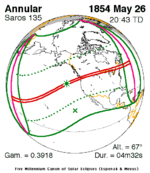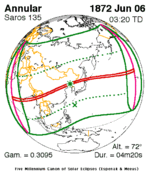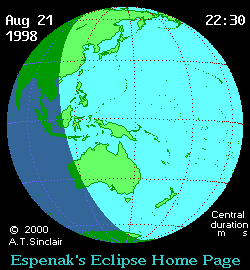An annular solar eclipse occurred at the Moon’s ascending node of the orbit on August 22, 1998. A solar eclipse occurs when the Moon passes between Earth and the Sun, thereby totally or partly obscuring the image of the Sun for a viewer on Earth. An annular solar eclipse occurs when the Moon's apparent diameter is smaller than the Sun's, blocking most of the Sun's light and causing the Sun to look like an annulus (ring). An annular eclipse appears as a partial eclipse over a region of the Earth thousands of kilometres wide. Annularity was visible in Indonesia, Malaysia, Papua New Guinea, Solomon Islands (Bellona Island and Rennell Island) and Vanuatu. Occurring only 5.2 days before apogee (Apogee on August 27, 1998), the Moon’s apparent diameter was 3.6% smaller than average.[1] [2] [3]
YouTube Encyclopedic
-
1/2Views:943 28873 163
-
"People Should Be Preparing, This Is So Serious" - Elon Musk WARNING (2021)
-
"Jack Horkheimer Star Gazer" 5 Minute Aug. 16 - 22, 2010
Transcription
Images
Related eclipses
Eclipses of 1998
- A total solar eclipse on February 26.
- A penumbral lunar eclipse on March 13.
- A penumbral lunar eclipse on August 8.
- An annular solar eclipse on August 22.
- A penumbral lunar eclipse on September 6.
Solar eclipses 1997–2000
This eclipse is a member of a semester series. An eclipse in a semester series of solar eclipses repeats approximately every 177 days and 4 hours (a semester) at alternating nodes of the Moon's orbit.[4]
| Descending node | Ascending node | |||||
|---|---|---|---|---|---|---|
| Saros | Map | Gamma | Saros | Map | Gamma | |
120 Chita, Russia |
1997 March 09 Total |
0.91830 | 125 | 1997 September 02 Partial (south) |
−1.03521 | |
130 Total eclipse near Guadeloupe |
1998 February 26 Total |
0.23909 | 135 | 1998 August 22 Annular |
−0.26441 | |
| 140 | 1999 February 16 Annular |
−0.47260 | 145 Totality from France |
1999 August 11 Total |
0.50623 | |
| 150 | 2000 February 05 Partial (south) |
−1.22325 | 155 | 2000 July 31 Partial (north) |
1.21664 | |
Partial solar eclipses on July 1, 2000 and December 25, 2000 occur in the next lunar year eclipse set.
Saros 135
It is a part of Saros cycle 135, repeating every 18 years, 11 days, containing 71 events. The series started with partial solar eclipse on July 5, 1331. It contains annular eclipses from October 21, 1511, through February 24, 2305, hybrid eclipses on March 8, 2323, and March 18, 2341, and total eclipses from March 29, 2359, through May 22, 2449. The series ends at member 71 as a partial eclipse on August 17, 2593. The longest duration of totality will be 2 minutes, 27 seconds on May 12, 2431.
| Series members 27–43 occur between 1800 and 2100: | ||
|---|---|---|
| 27 | 28 | 29 |
 Apr 24, 1800 |
 May 5, 1818 |
 May 15, 1836 |
| 30 | 31 | 32 |
 May 26, 1854 |
 Jun 6, 1872 |
 Jun 17, 1890 |
| 33 | 34 | 35 |
 Jun 28, 1908 |
 Jul 9, 1926 |
 Jul 20, 1944 |
| 36 | 37 | 38 |
 Jul 31, 1962 |
 Aug 10, 1980 |
 Aug 22, 1998 |
| 39 | 40 | 41 |
 Sep 1, 2016 |
 Sep 12, 2034 |
 Sep 22, 2052 |
| 42 | 43 | |
 Oct 4, 2070 |
 Oct 14, 2088 | |
Metonic series
The metonic series repeats eclipses every 19 years (6939.69 days), lasting about 5 cycles. Eclipses occur in nearly the same calendar date. In addition, the octon subseries repeats 1/5 of that or every 3.8 years (1387.94 days). All eclipses in this table occur at the Moon's ascending node.
| 21 eclipse events, progressing from south to north between June 10, 1964, and August 21, 2036 | ||||
|---|---|---|---|---|
| June 10–11 | March 27–29 | January 15–16 | November 3 | August 21–22 |
| 117 | 119 | 121 | 123 | 125 |
 June 10, 1964 |
 March 28, 1968 |
 January 16, 1972 |
 November 3, 1975 |
 August 22, 1979 |
| 127 | 129 | 131 | 133 | 135 |
 June 11, 1983 |
 March 29, 1987 |
 January 15, 1991 |
 November 3, 1994 |
 August 22, 1998 |
| 137 | 139 | 141 | 143 | 145 |
 June 10, 2002 |
 March 29, 2006 |
 January 15, 2010 |
 November 3, 2013 |
 August 21, 2017 |
| 147 | 149 | 151 | 153 | 155 |
 June 10, 2021 |
 March 29, 2025 |
 January 14, 2029 |
 November 3, 2032 |
 August 21, 2036 |
Notes
- ^ "Clouds may put eclipse in shade". The Sydney Morning Herald. Sydney, New South Wales, New South Wales, Australia. 1998-08-22. p. 5. Retrieved 2023-10-21 – via Newspapers.com.
- ^ "Saturday". Newsday (Suffolk Edition). 1998-08-19. p. 114. Retrieved 2023-10-21 – via Newspapers.com.
- ^ "Eclipse Aug. 23". Mitchell Tribune. 1998-08-05. p. 12. Retrieved 2023-10-21 – via Newspapers.com.
- ^ van Gent, R.H. "Solar- and Lunar-Eclipse Predictions from Antiquity to the Present". A Catalogue of Eclipse Cycles. Utrecht University. Retrieved 6 October 2018.
References
- Earth visibility chart and eclipse statistics Eclipse Predictions by Fred Espenak, NASA/GSFC
Photos:
- An Annular Eclipse of the Sun APOD 8/24/1998, from Mersing on the East Coast of Malaysia





